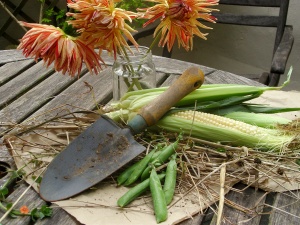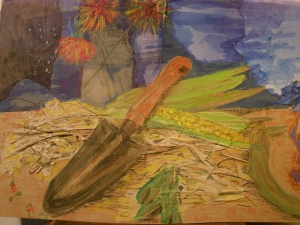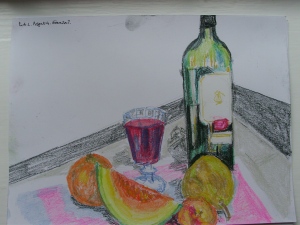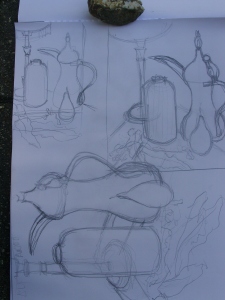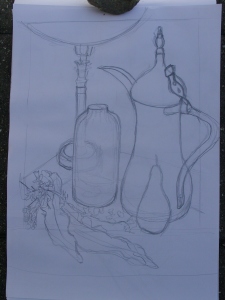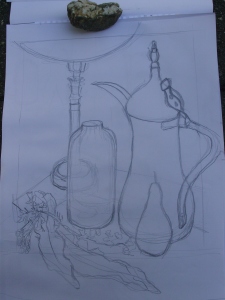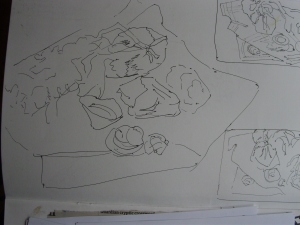Monochrome.
I wanted to be sure I understood the criteria for a monochrome, so I searched the Bridgeman Library under “Monochrome Still Life” and studied the results. I wondered how strictly the idea of a single colour had to be applied, and whether white and black were excluded as colours.
It seems that there is some lee-way, and some of the examples included browns, greys, yellow ochres and that the key is the subtly of shade differences. See Gillian Carnegie;
http://www.bridgemaneducation.com/ImageView.aspx?result=0&balid=397419
and Kenneth Newton:
http://www.bridgemaneducation.com/ImageView.aspx?result=23&balid=201267
In some the backgrounds were a single colour starkly applied and the composition was in white and black and browns and greys, as in this example by E. b Watts:
http://www.bridgemaneducation.com/ImageView.aspx?result=46&balid=77357
I was not surprised to see several by Morandi, in muted greys and beiges.
http://www.bridgemaneducation.com/ImageView.aspx?result=17&balid=407442.
The Tate definition of a monochrome work is tight. It states that it is a work with only one colour, or shades of one colour. It gives a historical account of the approach, citing the fact that for centuries artists diluted black or brown inks to produce drawing in one colour. The French then used grey oil paints to make works which became known as grisaille. This exploited the play of light and dark to define form, a principal known as chiaroscuro.
More recent examples include this work by Toulouse Lautrec:
http://www.bridgemaneducation.com/ImageView.aspx?result=16&balid=49635
and this by Childe Hassam:
http://www.bridgemaneducation.com/ImageView.aspx?result=7&balid=984943
In the twentieth century, abstract artists experimented with the concept. Artists who are notable for their work in this style being Kasimir Malevich, Ben Nicholson and Yves Klein. Yves Klein was famous for his series of blue monochromes.
With all this in mind, I decided to try two different compositions, one in yellows, which would probably stick loosely to the definition of monochrome, and one in beiges, which I hope will yeild a more purist result.
Four hours later, with the first effort:
The photos are not great. I did the drawing a day before I took the photos and the light was very different, so the shadows in the photo are much stronger and the colours paler.


I started by experimenting with different media, trying to establish which were best for the tonal range and surface textures.
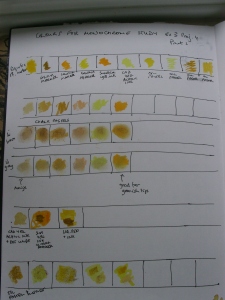
This showed me that fibre tips where not useful and that the best medium for blending was the soft pastels. I therefore chose to use acrlic paper with tooth as this was sufficiently robust to take the wet inks and the tooth held the pastels well.
I used an acrylic ink base for the drawing, this time managing to get the dark tones in first, but I did find it hard to mix and dilute the inks to differentiate between the tones and to represent the range.
I highlighted and further differentiated with soft pastels.
Overall, as a first attempt as a monochrome ever, I am quite pleased. I stood above the composition so as to see the tortilla chips in the bowl. The sweet corn was very pale and I have struggled to represent it , both in terms of its texture and the sheen on the nibs. I think the difference in texture between the shiny glass bottle and the chips is a fair result, but I have not really shown the texture of the glazed bowl, and am not sure how I could do this.
I didn’t see the slant to the right of the bottle. It wasn’t clear to me against the tiled wall, so the perspective is not accurate.
The tiles were really helpful in positioning the objects and getting their size accurate. This is something I still find difficult and frustrating.
Second Monochrome.
I wanted to try again, with a diffent colour palette and using different media.
The composition is inspired by a painting exhibited in the Summer exhibition at the Royal Academy.

Colour test chart:
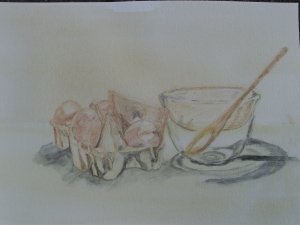
I used a watercolour wash and then drew with watercolour pencils, adding a few white highlights with an acrylic fibre tip pen.
I am pleased with the subtle colours and the airiness of the drawing. This was what I like about the Adrienne Blake painting.
I enjoyed using the watercolour pencils and I think they were a good choice for the subject and effect I wanted. The watercolour paper I had available is not A3, but I needed the surface and the thickness of the paper. I tried a watercolour wash on Fabriano paper, but it “buckled” , so I had to discard it.

